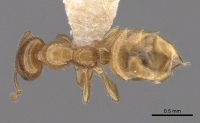Myrmelachista lauropacifica
| Myrmelachista lauropacifica | |
|---|---|

| |
| Scientific classification | |
| Kingdom: | Animalia |
| Phylum: | Arthropoda |
| Class: | Insecta |
| Order: | Hymenoptera |
| Family: | Formicidae |
| Subfamily: | Formicinae |
| Tribe: | Myrmelachistini |
| Genus: | Myrmelachista |
| Species: | M. lauropacifica |
| Binomial name | |
| Myrmelachista lauropacifica Longino, 2006 | |
Longino (2006) - This species occurs in mature wet forest in the southern Pacific lowlands. I have collected it in Corcovado National Park and Carara Biological Reserve. Colonies have been in live stems of Lauraceae, with a biology similar to Myrmelachista flavocotea. I found nests in O. cf. atirrensis and O. nicaraguensis. In Carara, O. nicaraguensis was common along the Quebrada Bonita. Small plants in the forest understory all contained M. lauropacifica, while larger plants in more insolated areas along the stream edge contained Azteca cf. pittieri and Pseudomyrmex viduus. (Longino 2006)
Identification
Longino (2006) - Worker with antenna 9-segmented, maxillary palpus 5-segmented, color yellow. Queen with orange head, eyes relatively large (OI 33–37), HW less than 0.8mm. Obligate inhabitant of understory Lauraceae.
Keys including this Species
- Key to Myrmelachista workers of Costa Rica
- Key to Myrmelachista queens of Costa Rica
- Key to Myrmelachista males of Costa Rica
Distribution
Latitudinal Distribution Pattern
Latitudinal Range: 9.783333333° to 8.55°.
| North Temperate |
North Subtropical |
Tropical | South Subtropical |
South Temperate |
- Source: AntMaps
Distribution based on Regional Taxon Lists
Neotropical Region: Costa Rica (type locality).
Distribution based on AntMaps
Distribution based on AntWeb specimens
Check data from AntWeb
Countries Occupied
| Number of countries occupied by this species based on AntWiki Regional Taxon Lists. In general, fewer countries occupied indicates a narrower range, while more countries indicates a more widespread species. |

|
Estimated Abundance
| Relative abundance based on number of AntMaps records per species (this species within the purple bar). Fewer records (to the left) indicates a less abundant/encountered species while more records (to the right) indicates more abundant/encountered species. |

|
Habitat
southern Pacific lowlands.
Biology
Castes
Worker
Images from AntWeb
 
| |
| Queen (alate/dealate). Specimen code jtlc000002715. Photographer J. Longino, uploaded by University of Utah. | Owned by JTLC. |
Queen
Images from AntWeb
  
| |
| Holotype queen lauropacifica. Queen (alate/dealate). Specimen code jtlc000006213. Photographer J. Longino, uploaded by University of Utah. | Owned by INBC. |
Male
Images from AntWeb

| |
| Male (alate). Specimen code jtlc000002708. Photographer J. Longino, uploaded by University of Utah. | Owned by JTLC. |
Nomenclature
The following information is derived from Barry Bolton's Online Catalogue of the Ants of the World.
- lauropacifica. Myrmelachista lauropacifica Longino, 2006a: 31, figs. 4, 6, 11, 13 (w.q.m.) COSTA RICA.
Unless otherwise noted the text for the remainder of this section is reported from the publication that includes the original description.
Description
Worker
HL 0.468–0.596, HW 0.414–0.537, SL 0.223–0.285, EL 0.098–0.110, CI 87–95 (n=4).
Same as Myrmelachista flavocotea.
Queen
HL 0.900–0.966, HW 0.738–0.787, SL 0.363–0.402, EL 0.261–0.276, OW 0.076–0.089, OD 0.133–0.155, CI 77–82, OI 33–37, OcI 8–9 (n=4).
Antenna 9-segmented; maxillary palpus 5 or 6-segmented; labrum short, bilobed, not covering mouthparts; dorsal surface of mandible with piligerous puncta, interspaces smooth or slightly roughened; face and clypeus smooth and shining; in full face view, with abundant long erect to suberect setae projecting from sides of head, setae on posterior margin shorter; ventral surface of head with abundant short erect setae; scapes with abundant erect to suberect setae, longer setae subequal to width of scape; outer surface of hind tibia with abundant erect to subdecumbent setae, longer setae shorter than width of tibia; color light yellow orange with infuscated bands on gastral terga.
Male
Antenna 10-segmented; maxillary palpus 6-segmented; pygostyles absent; basiparamere lobe short, weakly sclerotized, half the length of paramere or less, in one collection drawn out as thin, sharp point, in another reduced to short triangular tooth; paramere weakly sclerotized, parallel-sided with rounded apex; cuspis absent (at high magnification, barely visible as tiny remnant); digitus evenly curved downward, tapering to rounded point; apodeme of penial valve curving into dorsal margin at obtuse angle.
Type Material
Holotype alate queen: Costa Rica, Prov. Puntarenas, Cedral, Corcovado National Park, 8°33’N, 83°33’W, 50m, 15 Jul 1982 (J. Longino) Instituto Nacional de Biodiversidad, specimen code JTLC000006213.
Paratypes: workers and queens, from same nest as holotype, specimen codes JTLC000006214-JTLC000006218, distributed to Museum of Comparative Zoology, National Museum of Natural History, University of California, Davis, Los Angeles County Museum of Natural History, The Natural History Museum.
Etymology
The name refers to its association with plants in the family Lauraceae and its geographic distribution in the Pacific lowlands.

